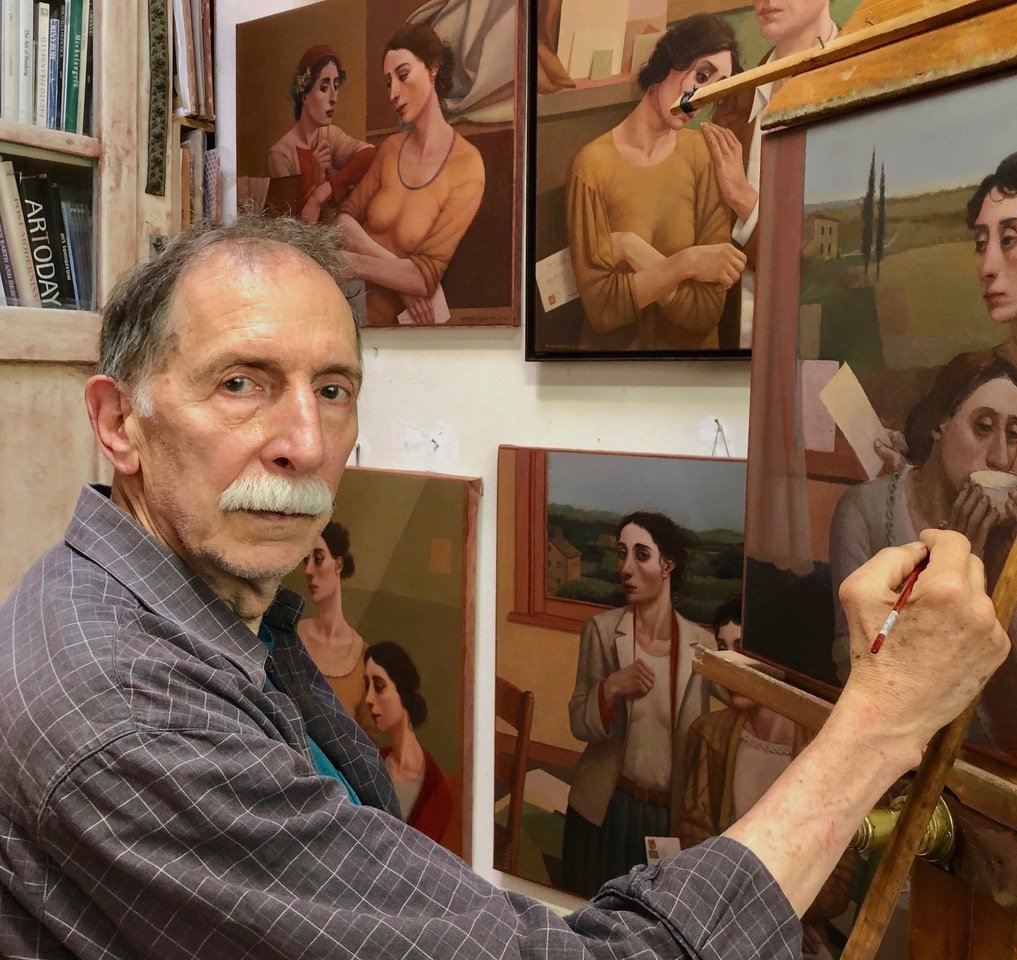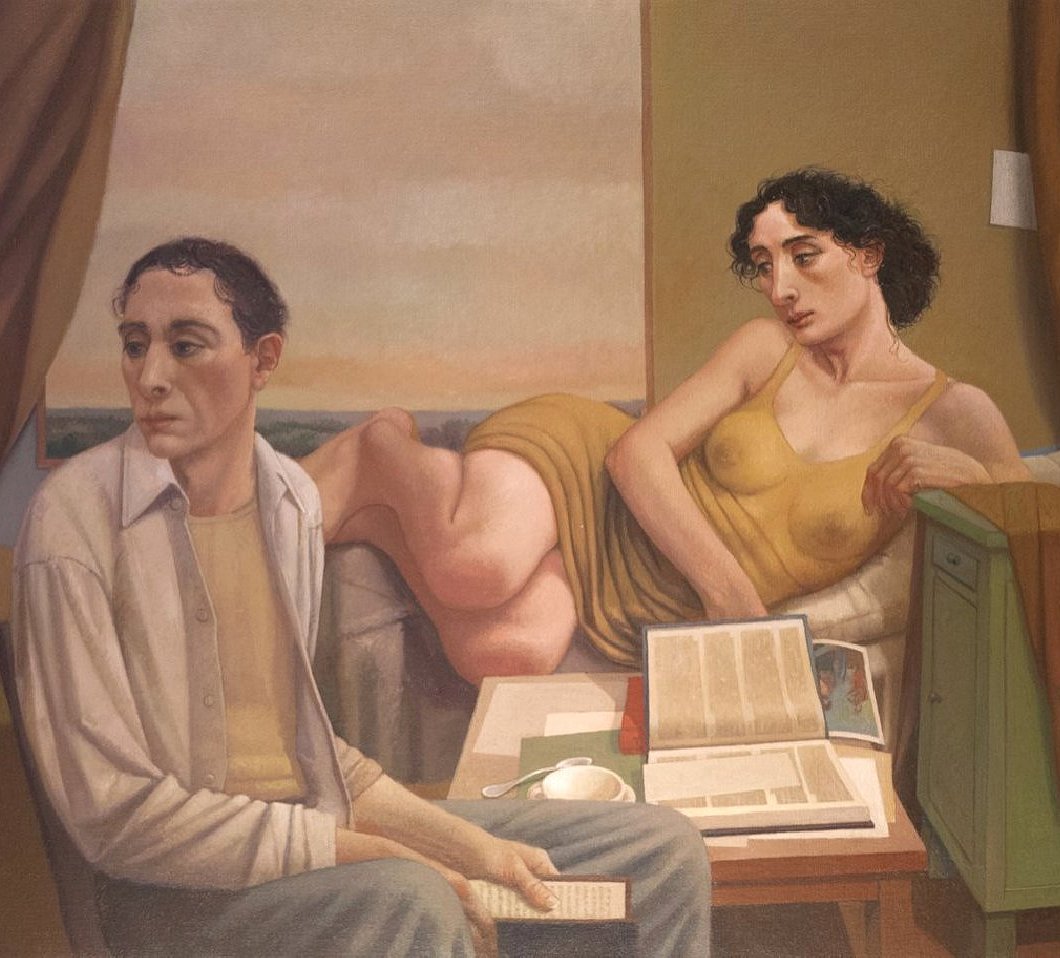“Art, whatever it takes” – The RomeArtProgram has made a series of interviews
with Artists living in Italy, the USA & the UK, to know their feelings and orientation
during these times of emergency.
Alan Feltus – American Painter – Washington, D.C. – living in Italy, Assisi since 1987. (Assisi, Italy).
RomeArtProgram: Where do you live ? What is your background ?
Alan: I live outside Assisi. After I was born in Washington DC, I lived in New York where I spent much of my younger years in the Metropolitan Museum and the Museum of Modern Art, and also in the studio of an artist friend of my mother. For my last year of high school I was at the Overseas School of Rome. After that I was an art student at the Tyler School of Art in Philadelphia and at Cooper Union in New York. For my MFA I was at Yale.
RAP: In your opinion is there a “creative method”?
Alan: My painting method is working without models and continuously changing what is in front of me. I consider a painting finished when I can’t see anything in it needing more repainting.
RAP: The “lock down moment” can set you on the path of some important change(s) in your creativity and style…Has this happened to you ?
Alan: The lockdown has not changed my work.
RAP: What normally inspires you? Which is the most important inspirational source you have found in Rome?
Alan: I like to wander the streets in Rome. I enter churches and museums to see what treasures they have. I like the particular atmosphere that is visual as well as about sounds and sometimes smells. The churches can have the silence I tend to feel most comfortable in and may have the scent of incense and candles. They are often only dimly lit from high windows. Their sculptures and paintings can have mysterious qualities, being about people and stories I may not know. Fragments of ancient architecture and sculpture are embedded in the walls of buildings where they may have been found during renovations. Pieces of Latin inscriptions carved in marble no longer able to spell out whole words are beautiful for what those bits and pieces can be as fragments of things that had their own stories that we can’t know.
I like tools and think about the men who used them to shape stone and wood and clay. In Rome, when the sky turns slate gray and then the sun pokes through the clouds and lights the earth yellows and reds of buildings against that dark gray, Rome is like no other city. I like how there is a different sense of order and design in the way products are displayed in stores. I like that a bar is not the dark and somber American bar partly lit by colored neon signs. It is where people have their coffee and pastry to start the day. I love the incongruity of things situated in streets and piazzas for no obvious reason. A few blocks from Piazza di Spagna, on Via del Babuino, there is an ancient grotesque Silenus, the mythological half man, half goat, old satyr god of drunkenness. To me, that strangely ugly figure of an old man reclining on rocks that feed water into a rectangular basin oddly situated on a fairly narrow street in the center of Rome is just one of those unexplained strangenesses in a city that has so many stories and so many mysteries. What inspires me most in Rome as a painter might be the Caravaggios and the works of the Italian painters made between the wars, and the city itself and its secrets.
RAP: Is there a difference in working in Rome for an artist? What art medium do you prefer to work in?
Alan: If Rome can be where one works, it should be a positive experience for any of us. I paint in oils on canvas.
RAP: Specific events and historical conditions have a significant role in the creative process; how does this pandemic emergency affect the Arts?
Alan: Being confined to my home and studio has not been a hardship for me. The pandemic and the political situation in the US have created stresses that I have to live with, but my own paintings have never been about what is happening in the news. It is sad to learn of museums and performances suffering from the lockdown. We all look forward to better times ahead.
RAP: How are you feeling at this difficult moment and what made you feel this way? …are you optimistic for the future?
Alan: Most of us have survived difficult times in our lives. What is most disturbing at this moment is that our future survival, itself, is not certain. I try to be optimistic.
RAP: What can Art contribute to history? Will “Art save us” ?
Alan: The art that survives remains what it always was, while on the other hand, recorded history, which is the story of mainly political events, is something that gets reinterpreted repeatedly, and, in time, tends to be forgotten.
RAP: What is your most ambitious dream?…and the greatest sacrifice that you have made for your Art?
Alan: My most ambitious dream was to live in Italy with my family, and to be able to support us on painting sales. I made that possible starting when I gave up full-time teaching in 1984, and three years later moved to Italy. The move was not without some hardships, and there have been periods when painting sales had slowed down. But it has worked out well.
RAP: Recently, the artistic and cultural message of Italy and Rome was reemerging as a great “work in progress”,…is this your point of view?
Alan: I don’t see Rome as any kind of work in progress. What I love about Rome is that it stays fairly unchanged.
RAP: Which is your favorite Italian, or Roman, place(s) of art (Museum, Gallery, Monument…)?
Alan: Rome will always remain the most important place in Italy for me, but almost equally I love Venice, Florence, Siena, Orvieto and other places. Each is unique in its architecture, due to what building materials were found on site. But not so with Venice, of course. Venice was built on a lagoon, on wood piles that miraculously support the massive weight of a stone city situated just barely above water level. I think of Venice as a marvelous impossibility.
RAP: Which period of Italian Art do you prefer? What is your favorite Italian work of art?
Alan: I am interested in Etruscan, Roman, medieval and Renaissance art, and mannerist painting. Then it might skip some to early 20th century painting. Felice Casorati’s Susanna is one of the most important paintings for me as an influence. Carpaccio’s Two Venetian Ladies, also titled the Courtesans, in the Correr Museum in Venice is another.
RAP: How has Rome personally influenced you as an artist and a person?
Alan: At age seventeen, living in Rome reshaped my being. Then and there I knew I wanted to be an artist. In Rome I found myself living in a museum turned inside out. The culture of centuries is simply there, unpretentiously part of everyday life in a beautifully romantic city. I loved seeing ancient Roman sarcophagi in courtyards once there to hold water for horses now used to wash the little cinquecento car belonging to a family upstairs living their Fellini lives.
While at the American Academy in Rome ten years later, after art school, I came upon Felice Casorati’s 1929 painting titled Susanna, hanging in the Galleria Nazionale d’Arte Moderna e Contemporanea, and that one painting, of all the paintings I was looking at, seemed to have everything I wanted to have in my own paintings. My paintings from then on have been paintings of one or two or three figures mostly in interior spaces, painted without models. My later decision to move to Italy was certainly influenced by living in Rome.
I first came to know Rome when I was living there with my mother, when I was seventeen and still the quiet, shy silent observer I was as a child in New York, unable to make friends with schoolmates outside of classrooms. I spent my non-school days wandering the streets, getting lost in parts of the city I didn’t know and returning to favorite places. Being by myself and not in the shadow of my mother and the people she surrounded herself with, I was no longer a child. The things I experienced were mine. They seemed personal and private. It was like watching a movie that I was in, with Rome as the setting. I was beginning to know myself as a young man. So the timing was important. Rome was a quieter and less touristed city in 1960. I found it to be very romantic. Those were good times for me. Nostalgic times.
RAP: What’s your goal? What role does the artist have in society? Any final thoughts and advice?
Alan: I suppose I have achieved my goal by now. My advice… Find your inner self and make personal paintings. Live surrounded by great art, even if that is in books.
www.Alanfeltus.com
www.ForumGallery.com
RomeArtProgram is ready to bounce back!
___________________
RomeArtProgram
#romeartprogram
Art-as-Power


